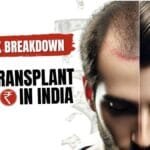Hair transplant techniques have transformed how we treat hair loss today. Hair loss can deeply affect how we look and feel. As a cosmetic surgeon practising in Delhi for over two decades, I have seen how thinning hair impacts confidence and self-image.
Many patients walk into my clinic, Care Well Medical Centre, asking a simple question:
“Which hair transplant technique is the best for me, Doctor?”
Many patients ask me about the differences between various hair transplant techniques and which one might suit them best.
The truth is, there is no single “best” method. Each technique—whether it is FUE, FUT, DHI, or Robotic—has its own benefits, costs, recovery time, and ideal candidates.
In this guide, I will help you understand how these techniques differ. My goal is to clear your doubts and help you make a confident choice.
If you are exploring hair restoration options in Delhi, I invite you to check out our latest Hair Transplant Techniques in Delhi for expert insights and practical tips. It covers everything from costs to results, and will connect you to detailed pages for each method.
Let us explore these techniques step by step, so you can decide what suits you best.
What Are Hair Transplant Techniques?
Hair transplant techniques are advanced medical procedures to restore hair where it has thinned or disappeared. In simple terms, they involve moving healthy hair follicles from a dense area of your scalp (the donor site) to bald or thinning areas (the recipient site).
Over the past two decades, I have seen incredible progress in this field here in Delhi. Today, we have multiple techniques, each offering unique benefits and suitable for different types of hair loss.
Key things to know about hair transplant techniques:
- They focus on natural-looking results and matching your existing hairline.
- Techniques vary in how hair follicles are removed and placed.
- Recovery times differ based on the method chosen.
- Costs can vary widely, depending on technology and surgeon expertise.
- Not every technique suits every patient.
Choosing the right hair transplant techniques is essential for long-lasting, natural results. I always guide my patients based on their hair type, scalp condition, and personal expectations.
In the next sections, I will explain each technique—FUE, FUT, DHI, and Robotic—in detail, so you can understand which might work best for you.
Why Choosing the Right Hair Transplant Technique Matters
Many people believe all hair transplant methods give the same results. But as a cosmetic surgeon in Delhi, I can tell you that choosing the right technique makes a huge difference.
Your choice affects not just how you look—but also how you feel during recovery and how natural your hair appears in the long run.
Here is why this decision matters:
- Natural Appearance: Each technique offers different levels of density, hairline precision, and natural-looking angles.
- Scarring: Some methods leave minimal dot-like scars, while others may leave a linear scar.
- Recovery Time: Healing time can vary from a few days to several weeks, depending on the method.
- Pain & Discomfort: While most modern techniques are minimally painful, some involve more discomfort during or after surgery.
- Cost: Advanced techniques like Robotic or DHI often cost more than traditional methods.
- Suitability: Not every technique works for every patient. Factors like donor hair quality, scalp health, and previous surgeries play a big role.
I always advise my patients to look beyond marketing claims and understand what each method truly offers. For example, a patient with limited donor hair may be better suited for FUT than FUE. Another patient focused on no visible scarring might prefer FUE or DHI.
It is my job at Care Well Medical Centre to help you choose wisely, so you invest in a solution that gives lasting, satisfying results.
In the next sections, I will break down each technique—so you can see the pros, cons, and costs for yourself.
Types of Hair Transplant Techniques
When someone visits me at Care Well Medical Centre in Delhi, they often tell me:
“Doctor, I am confused by all these names—FUE, FUT, DHI, Robotic. What do they really mean?”
I completely understand. As a surgeon, I have seen how overwhelming it feels when you are deciding about your hair, your look, and your future confidence.
Let me explain it in simple terms. All these hair transplant techniques are ways to move healthy hair from a donor area (usually the back of your scalp) to the thinning or bald areas. But how we do that makes each technique unique.
Here is how I usually explain it to my patients:
- FUE (Follicular Unit Extraction):
Think of it like picking individual flowers from a garden. We extract hair follicles one by one, leaving tiny dot-like scars that are hardly visible. Recovery is quick, and it suits people who love short hairstyles. - FUT (Follicular Unit Transplantation):
This is like removing a small strip of turf from a lawn. We take a thin strip of scalp, then separate the hair follicles under a microscope. It leaves a linear scar but often allows us to harvest a larger number of grafts in one session. - DHI (Direct Hair Implantation):
An advanced method where we use a special pen-like tool to implant the follicles directly. This gives me better control over the angle, depth, and placement of each graft, often creating very natural results. It can cost a bit more but offers excellent precision. - Robotic Hair Transplant:
Here, a robotic arm assists in extracting or implanting hair follicles. The robot helps improve accuracy and speed, especially in large sessions. However, not every clinic offers this technology, and it tends to be more expensive.
Each technique has its own place. One method is not automatically “better” than the others. The best choice depends on your hair type, how much hair you have left in the donor area, your goals, and your lifestyle.
Follicular Unit Extraction (FUE)
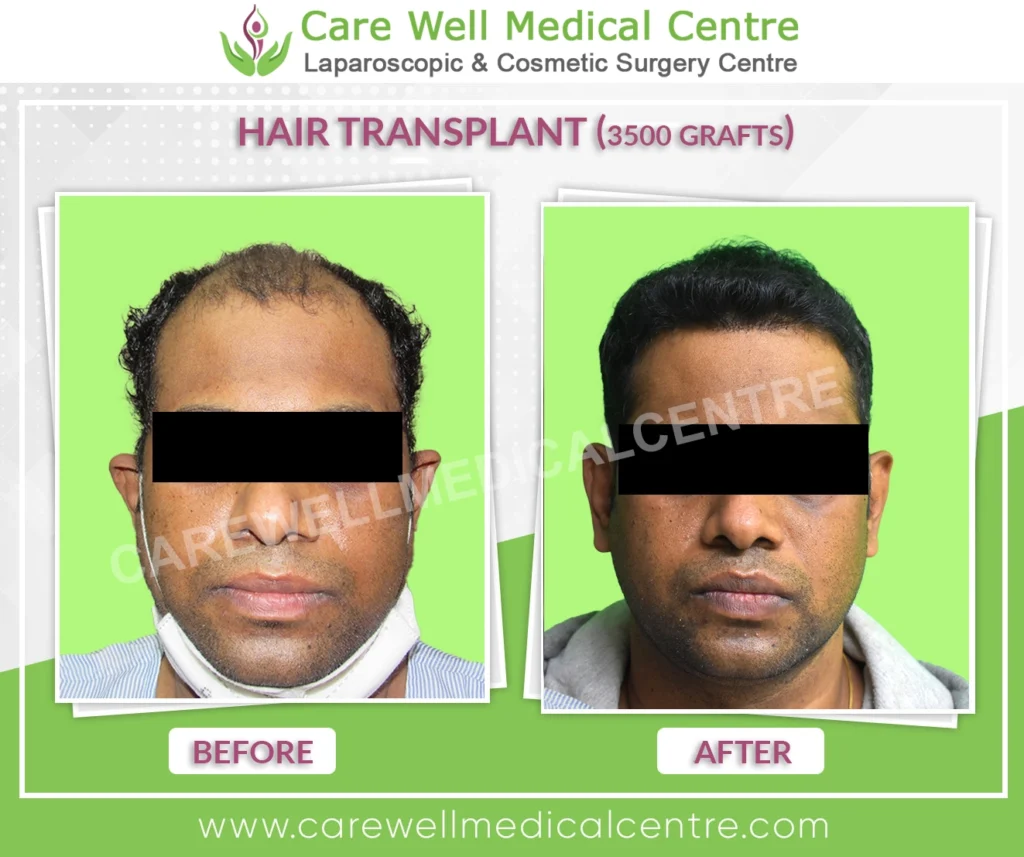
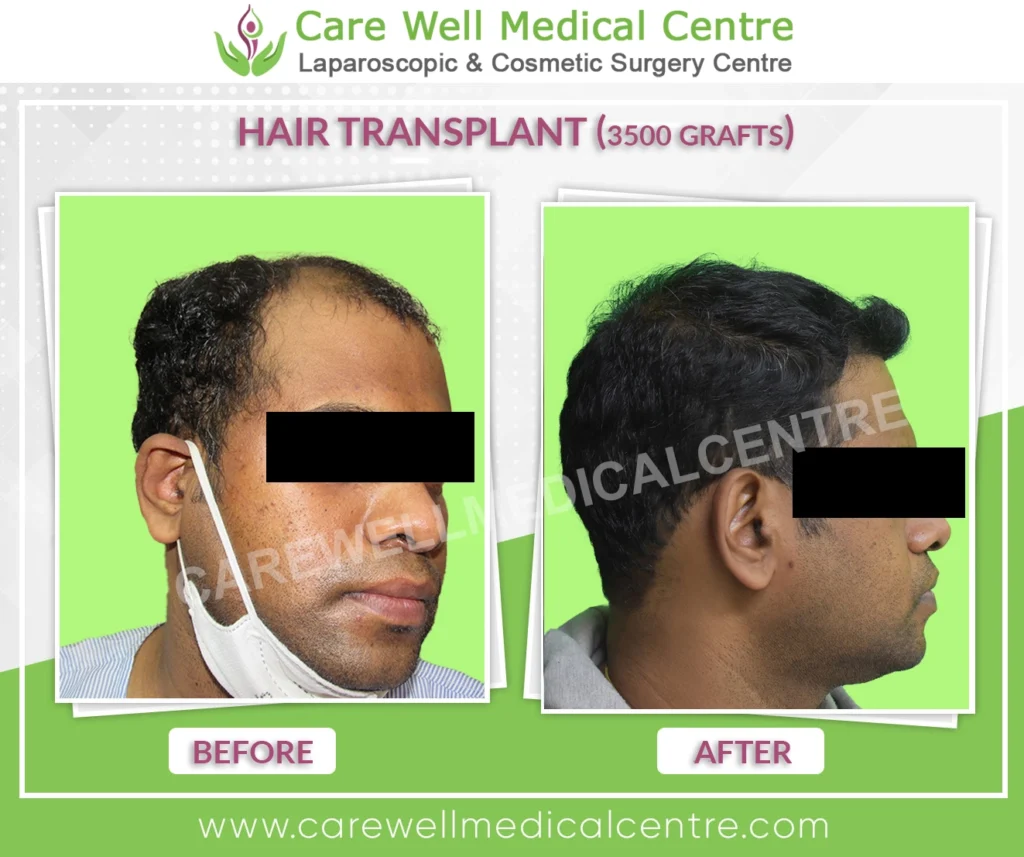
At my clinic in Delhi, many patients tell me,
“Doctor, I have read about FUE everywhere. Is it really scarless and safe?”
I love answering this because FUE has truly changed how we approach hair restoration.
Let me explain it in simple words.
FUE stands for Follicular Unit Extraction. Imagine you have a garden of healthy hair at the back of your head. With FUE, I carefully pick each “flower” — meaning, each hair follicle — one by one, using tiny instruments. These are then placed into thinning areas to recreate your natural hairline and density. For a full step-by-step breakdown, see my guide on “What is FUE Hair Transplant?” where I explain the process in detail.
Why do so many people prefer FUE?
- Minimal Scarring: Instead of a big scar, it leaves only tiny dot-like marks that are almost invisible, even with short hair.
- Quick Recovery: Most patients return to work or social life in just a few days.
- Comfortable Experience: Many tell me they feel surprisingly comfortable during the procedure.
- Great for Short Haircuts: Perfect for men and women who like shorter styles.
- Precision: I can select the healthiest follicles and control density with care.
But like every technique, FUE has its limitations:
- It takes more time because each follicle is removed individually.
- Fewer grafts might be harvested in one session compared to FUT.
- Costs can be slightly higher due to the precision and time involved.
In my practice at Care Well Medical Centre, I usually recommend FUE to patients who:
- Want minimal visible scarring.
- Have smaller bald patches or thinning.
- Prefer shorter hair styles.
- Wish for a gentle, quicker recovery.
Here’s something important:
FUE is not automatically the “best” for everyone. The best technique is always the one that fits your hair, goals, and lifestyle.
If you’re exploring FUE in Delhi, see how I perform FUE hair transplants and what you can expect.
In short, FUE is a precise, gentle method that gives natural results with minimal downtime — perfect for many, but not for all.
Next, let me explain FUT, another trusted technique I use regularly.
Follicular Unit Transplantation (FUT)
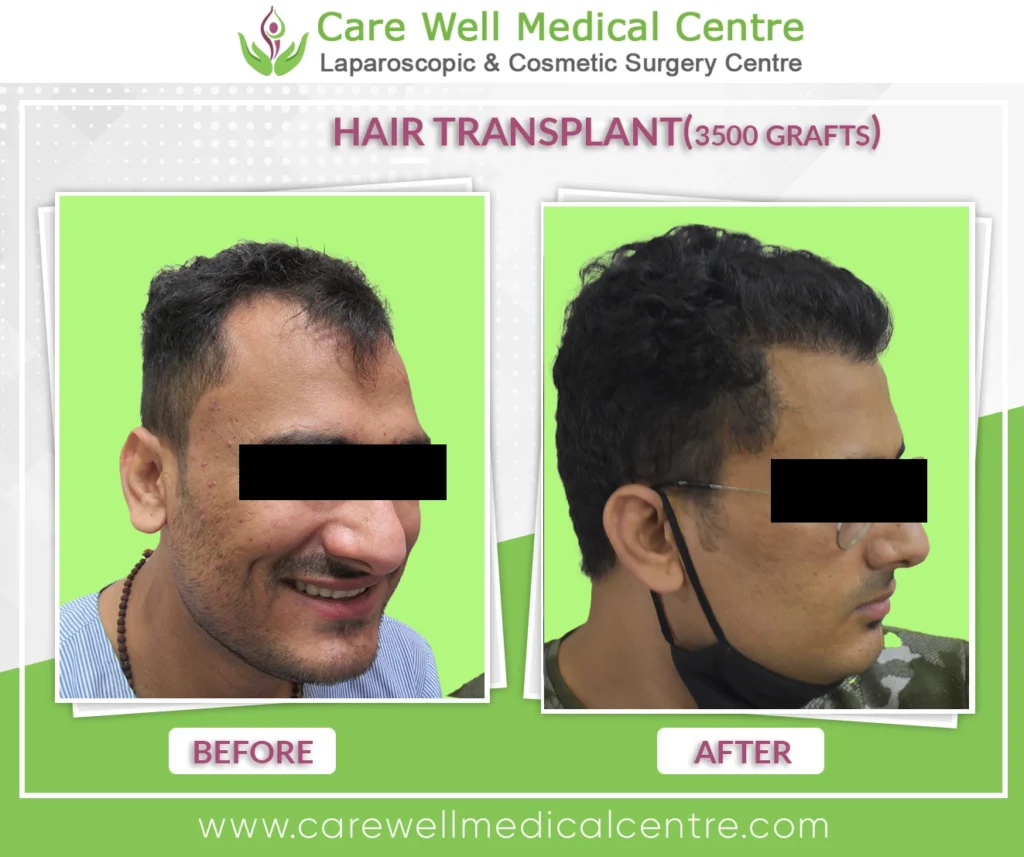
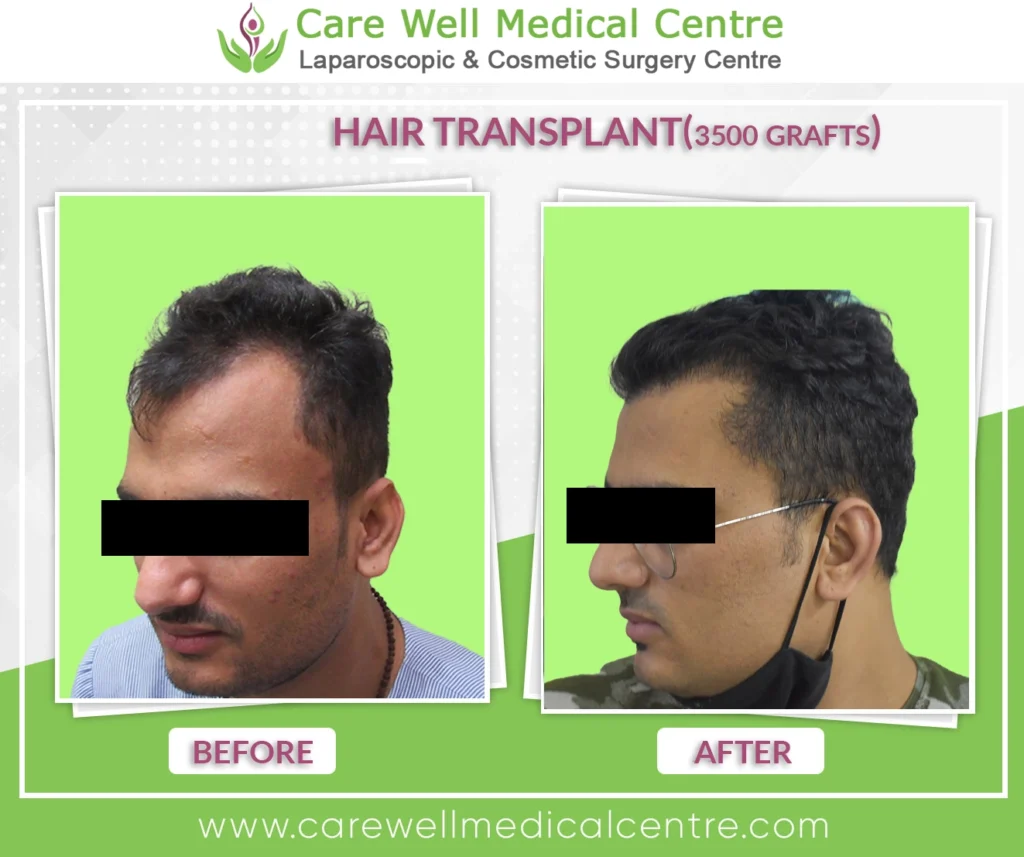
A few months ago, a gentleman named Rajesh came to see me at Care Well Medical Centre in Delhi. He was worried about significant hair loss and wanted maximum coverage in a single sitting. He asked:
“Doctor, everyone talks about FUE nowadays. Is FUT still relevant?”
I smiled and told him the truth: FUT has been around longer than FUE—and for good reason.
Here’s how I explained it to Rajesh:
In FUT, we remove a thin strip of skin from the back of your scalp. From this strip, my team and I separate thousands of individual hair grafts under high-powered microscopes. These grafts are then implanted into the thinning areas, carefully matching the natural angles and density of your original hair. Curious how FUT really works? See my in-depth guide on “What is FUT hair transplant?” for a complete explanation.
Many people worry about the scar, but here is the reality:
- The scar is a fine line, often hidden under longer hair.
- With modern techniques, I make this scar as thin and neat as possible.
- For patients who keep their hair longer, it is usually never visible.
Why I sometimes recommend FUT:
- It allows me to harvest a large number of grafts in one sitting.
- It is very efficient for patients with advanced hair loss.
- The cost per graft can be lower than newer techniques.
- The results, when done right, look completely natural.
However, it is not for everyone. Patients who prefer very short hairstyles might not be ideal candidates because the linear scar could become visible.
For Rajesh, FUT was perfect. He wanted maximum density, planned to keep his hair longer, and did not mind a small scar hidden under his hair. Six months later, he came back smiling, with a fuller hairline and restored confidence.
“Doctor, I wish I had done this sooner,” he told me.
So, if you are considering hair transplant, do not dismiss FUT just because it sounds “old.” In skilled hands, it remains a trusted and effective technique. For more details on FUT and whether it suits your hair loss pattern, see how I approach FUT transplants at my clinic in Delhi.
Next, I will share details about DHI—a newer method that has been getting a lot of attention.
Direct Hair Implantation (DHI)
Whenever I think about how far hair restoration has come, DHI is one of the techniques that makes me pause and feel genuinely excited.
Over the years, as a surgeon practising in Delhi, I have realised one simple truth: a hair transplant is not just about filling empty spaces. It is about recreating the natural angles, direction, and softness of hair — so that even under bright sunlight, no one can tell the difference.
That is exactly where DHI has changed my practice.
Unlike traditional methods, DHI gives me the power to control how each single hair is placed — its angle, its depth, its direction. I use a special tool, like a delicate pen, to implant follicles directly into the scalp.
This level of control means I can create:
- Softer, natural hairlines
- Higher density in smaller areas
- Less trauma to the scalp
Yet, I never call DHI the “best” technique for everyone.
It demands more surgical time, a steady hand, and extra cost because of specialised tools and training. Some patients might not need this level of detail if their goals are simpler.
For me, DHI is a beautiful tool in my surgical kit — not a miracle.
It is perfect for patients who want the most natural look, especially at the hairline, and who are ready for the time and cost it demands.
I feel proud offering DHI at Care Well Medical Centre, but I always remind my patients:
“Technology is powerful, but the surgeon’s vision makes the real difference.”
Next, I would like to share my thoughts on Robotic Hair Transplant — a topic that often fascinates patients for its futuristic promise.
Robotic Hair Transplant
Technology never stops fascinating me. As a cosmetic surgeon in Delhi, I have seen how machines and medicine are merging in ways we could not have imagined twenty years ago.
One of the most talked-about advances in hair restoration is the Robotic Hair Transplant. Patients often ask me:
“Doctor, does a robot really perform the surgery?”
Here’s the truth.
Robotic hair transplant is not about a machine replacing a surgeon. It is about using robotics to assist us with precision and speed. The robot’s job is usually to help extract hair follicles from the donor area. It scans the scalp, calculates angles, and uses tiny punches to remove follicles accurately.
In my opinion, the biggest advantages of robotic systems are:
- Consistency: The machine does not get tired or distracted. It can maintain the same accuracy hour after hour.
- Speed: Large sessions can sometimes be performed faster with robotic assistance.
- Precision: It analyses the scalp in real time, helping avoid damage to healthy hairs.
But I always remind my patients:
Robots do not create artistry.
The artistic part of designing your hairline, deciding where to place each graft, and achieving a natural look — that still remains entirely in the hands of your surgeon.
Also, robotic transplants are:
- Not available in every clinic.
- Usually more expensive due to the high cost of the machines.
- Better suited for certain types of hair and scalp conditions.
At Care Well Medical Centre, I believe technology is wonderful, but it should never replace human judgment or experience. Robotics is a helpful tool — but like any tool, it depends on how wisely we use it.
“A good robot can extract hair. But only a good surgeon can give you your confidence back.”
Next, let’s look at how all these methods compare side by side, so you can understand which might fit your goals best.
FUE vs FUT vs DHI vs Robotic – A Detailed Comparison
Whenever someone asks me, “Doctor, which hair transplant technique is the best?” — I pause for a moment. Because there is no single answer that fits everyone.
Over my years of practice at Care Well Medical Centre in Delhi, I have learned one powerful truth:
“The best technique is not the one that’s most advanced or expensive. It’s the one that fits you.”
Let me explain how I think about it.
If you want minimal scars because you prefer short hair, my first thoughts go toward FUE or DHI. These methods leave tiny dot-like marks, almost invisible even under close inspection.
But if you are dealing with significant hair loss and want the highest number of grafts in one session, I may suggest FUT. Yes, it involves removing a thin strip of scalp, leaving a linear scar. But that scar often remains hidden under longer hair and allows me to extract more grafts in a single sitting.
DHI excites me as a surgeon. The precision it offers in placing each graft is remarkable. For hairlines or delicate areas, the implanter pen is a brilliant tool. But it comes at a higher cost and takes more time.
As for Robotic Hair Transplant, technology fascinates me. Robots help maintain precision during long surgeries and reduce fatigue-related errors. However, no machine can design a natural hairline or understand your facial proportions. That artistry still belongs to the surgeon’s vision and experience.
In my view, these hair transplant techniques are not rivals. They are tools. And as your surgeon, my job is to choose the right tool for your unique hair, scalp, and goals.
Here’s how I summarise it for my patients:
| Factor | FUT | FUE | DHI | Robotic |
| Scarring | Linear scar | Tiny dots | Tiny dots | Tiny dots |
| Recovery Time | Longer | Faster | Faster | Faster |
| Cost | Lower per graft | Medium | Higher | Highest |
| Graft Yield | Highest in one go | Moderate | Moderate | Moderate to High |
| Best For | Large bald areas | Short hairstyles | Natural hairlines | High-volume cases |
| Naturalness | Excellent | Excellent | Highly precise | Highly precise |
Want to explore these methods further? Check out my in-depth articles on FUE hair transplant and FUT hair transplant for detailed step-by-step insights.
If you feel lost choosing, remember:
“Your hair transplant should fit your life, your personality, and your future goals — not just a trend.”
That’s how I guide my patients every single day at Care Well Medical Centre here in Delhi.
Next, I want to share some exciting new advances transforming hair restoration even further.
Latest Advances in Hair Transplant Techniques
Every year, new innovations keep transforming how we approach hair restoration. As a surgeon in Delhi who has been in this field for over two decades, I find it both thrilling and challenging to stay at the forefront of these changes.
Some advances are simply tweaks to existing methods. Others bring entirely new possibilities to the table. Let me share a few that excite me the most as a practitioner at Care Well Medical Centre.
AI-Assisted Hair Transplant Planning
Artificial intelligence is entering our field fast. Modern software can analyse scalp photos, measure hair density, and suggest the best angles and patterns for graft placement.
While AI tools help improve planning, I always remind my patients:
“Technology can guide us, but the final artistic decisions still come from human experience.”
Sapphire FUE
Instead of traditional steel punches, Sapphire FUE uses blades made from sapphire crystals. These blades allow:
- Finer incisions
- Less tissue trauma
- Faster healing
- Potentially higher graft survival rates
It is not a revolution, but a significant refinement for patients seeking minimal scarring and precision.
Robotic Upgrades
Robotic systems are becoming smarter. Newer models can:
- Scan and map the scalp in real-time
- Adjust punch depth for different scalp thickness
- Reduce human fatigue in long surgeries
But as I have always believed, no robot can replace the surgeon’s eye for beauty and balance. Technology helps me, but it does not replace me.
Micro and Nano Grafts
Earlier, hair transplants used larger grafts, which sometimes looked unnatural. Now we can transplant single hair units (micrografts) or even split hairs into smaller fragments (nanografts) for:
- Softer hairlines
- Natural density transitions
- Less “pluggy” appearance
This is especially helpful for temples, hairlines, and eyebrows.
Bio-Enhanced Transplants
Research is exploring how growth factors, stem cells, and PRP (Platelet-Rich Plasma) can improve hair transplant results. The goal is to:
- Speed up healing
- Boost graft survival
- Enhance overall hair quality
While these methods are promising, I always tell my patients that scientific evidence is still evolving, and not all “miracle” claims are true.
My Personal Take:
I believe technology should always serve people, not the other way around. It is my job to combine these new advances with careful planning, artistic vision, and a deep understanding of each patient’s needs.
At Care Well Medical Centre, we keep upgrading our tools and skills, but my guiding principle remains simple:
“A beautiful result comes from technology guided by human experience.”
Next, let me help you understand how to choose the best hair transplant technique for your unique journey.
How to Choose the Best Hair Transplant Technique in Delhi
Patients sometimes believe a fancy machine or a new technique guarantees perfect results.
But here’s the reality:
“A skilled surgeon makes the difference between a natural-looking hair transplant and a visible one.”
Artistry matters as much as technology. Choosing a technique without evaluating the doctor’s experience is like buying a high-end camera without knowing how to take a photograph.
Ask Yourself These Questions
When I sit down with a patient, these are the questions I help them answer:
- How much hair loss do I have?
- Small patches might suit FUE or DHI.
- Large bald areas might benefit from FUT’s higher graft yield.
- How short do I keep my hair?
- Short styles work well with FUE or DHI because scarring is minimal.
- Longer hair can easily cover a FUT scar.
- Am I looking for maximum density?
- FUT and DHI are great for high-density goals.
- What is my budget?
- Techniques like DHI and Robotic are more expensive.
- FUT can be more budget-friendly for larger areas.
- How fast do I want to recover?
- FUE and DHI often have quicker downtime.
Trust the Surgeon, Not Just the Technique
Some patients think a fancy machine guarantees perfect results.
But here’s the truth:
A skilled surgeon makes the difference between natural and obvious results.
Check the Clinic’s Technology and Experience
In Delhi, many clinics offer modern tools. But I encourage patients to ask:
- Does the clinic perform all techniques or only one?
- Can they show a hair Transplant before-and-after photo gallery of real patients?
- Are surgeons personally involved, or do technicians do most of the work?
- What safety protocols are in place?
Consider Future Hair Loss
One key mistake I see is patients focusing only on immediate results. But hair loss can progress over time. The chosen technique should preserve donor hair for the future, especially if more procedures are needed later.
My Personal Advice
I always tell my patients at Care Well Medical Centre:
“Choose the method that fits your hair, your life, and your future—not just what sounds trendy.”
I am happy to guide anyone considering hair restoration.
Next, let me answer some common questions people ask me about hair transplant techniques.
When patients visit me at Care Well Medical Centre, our journey always begins with a detailed consultation. I carefully examine the scalp, check hair density, and look for any conditions like scarring or thinning patterns.
We also discuss your medical history to ensure you are fit for the procedure. I draw and design a natural hairline that suits your face, age, and future hair loss pattern.
My goal is to set realistic expectations so that you feel confident and fully understand your options. Every hair transplant plan I create is tailored just for you.
“A good hair transplant starts long before the surgery — it begins with listening to your story.”
What Happens on Hair Transplant Day?
Many of my patients feel nervous before their hair transplant. It is completely normal. Let me walk you through what happens on the day of your procedure, so you know exactly what to expect.
You will arrive at Care Well Medical Centre in the morning. We will greet you and help you settle in comfortably. If needed, I may shave or trim a small part of your donor area.
I will then numb your scalp with local anaesthesia. The process is quite gentle, and most patients tell me they feel very little discomfort.
Depending on the technique—FUE, FUT, DHI, or Robotic—the procedure usually takes 4 to 8 hours. You can relax during the surgery. Many patients listen to music, watch TV, or even nap while we work.
Once we finish, you can usually go home the same day. We place a small bandage over the donor area and give you simple instructions to care for your scalp.
A team member and I will also check in with you in the following days to make sure you’re healing well and feeling confident about your progress.
“Hair transplant day is not something to fear—it’s the beginning of your journey to new confidence.”
Pre- and Post-Procedure Care for Hair Transplant
When patients visit me at Care Well Medical Centre in Delhi, they often ask:
“Doctor, is there anything I should or should not do before and after a hair transplant?”
Yes — a few small steps make a big difference in results and recovery.
Before Your Hair Transplant
- Avoid alcohol and smoking for at least a week before your procedure. They slow down healing.
- Stop blood thinners or certain medicines, but only after talking to your doctor.
- Get good sleep the night before surgery.
After Your Hair Transplant
- Be gentle while washing your hair. I usually advise patients to avoid direct shower pressure on the scalp for a few days.
- Sleep with your head slightly elevated. It helps reduce swelling.
- Avoid touching or scratching the transplanted area.
- Hold off on intense exercise, gym, swimming, or heavy lifting for at least 7–10 days.
Potential Risks and Complications of Hair Transplant
Hair transplant is a safe procedure when done by skilled hands. But as a surgeon in Delhi for over twenty years, I believe in being honest with my patients.
Like any medical procedure, hair transplants carry some risks, though serious problems are rare.
Here’s what you should know:
- Swelling: Mild swelling around the forehead or eyes can happen for a few days.
- Infection (rare): We follow strict sterilization, but any surgery carries a small risk of infection.
- Temporary Numbness: You may feel some numbness or tingling in the scalp. It usually fades within weeks.
- Shock Loss: Sometimes existing hair near the transplanted area sheds temporarily. New hair usually grows back.
These risks are manageable and rare when performed in the right clinic. I always discuss these points in detail during consultations at Care Well Medical Centre.
“Good results come from being informed, not just hopeful.”
If you have any concerns, please feel free to ask. My goal is for you to feel safe and confident every step of the way.
Maintenance and Long-Term Care After Hair Transplant
Many people believe that once a hair transplant is done, there’s nothing else to worry about. But as a surgeon in Delhi for over two decades, I can tell you — good hair needs care even after surgery.
At Care Well Medical Centre, I always guide my patients on how to protect their results for years to come.
Some tools and habits I often recommend are:
- Minoxidil: Helps strengthen existing hair and sometimes boosts new growth.
- Finasteride: Can slow further hair loss, especially in male pattern baldness.
- PRP Therapy: Injecting platelet-rich plasma may improve hair density and health in some patients.
- Healthy Hair Care: Gentle washing, avoiding harsh chemicals, and protecting your scalp from sun damage all help maintain results.
Remember, transplanted hair is permanent. But your natural hair can still thin with age or genetics. Taking care of your overall hair health keeps everything looking natural and full.
I always tailor maintenance plans based on each patient’s needs. If you’re curious about long-term care options, I’m happy to discuss them during your consultation.
Conclusion
Choosing the right hair transplant techniques is not just about filling empty spaces on the scalp. It is about restoring confidence, self-esteem, and how you feel about yourself every single day.
As a cosmetic surgeon in Delhi, my commitment is always the same — to help you find the hair transplant technique that fits your unique needs, lifestyle, and future goals.
I hope this guide has made things clearer for you. If you are considering hair transplant, remember:
“There is no single best technique — only the best technique for you.”
I am here to help you make that decision with complete honesty and care. As a member of the Indian Association of Aesthetic Plastic Surgeons (IAAPS), I stay committed to the highest standards of patient care and surgical expertise.
FAQs & Common Myths About Hair Transplant Techniques
From my experience, all modern techniques—FUE, FUT, DHI, and even Robotic—can achieve natural results when performed correctly. The true magic lies in how your surgeon designs your hairline and places each graft. At Care Well Medical Centre in Delhi, my focus is always on creating a hairline that looks completely natural, even under bright lights or close inspection.
Robotic systems can bring great precision and reduce fatigue during long surgeries. However, robots cannot replace human artistry. Designing a natural hairline, understanding facial proportions, and making aesthetic decisions still depend on a skilled surgeon’s eye and experience.
FUE and DHI leave tiny dot-like scars that are almost invisible, even for patients who prefer short haircuts. FUT leaves a linear scar, which usually stays hidden under longer hair. Robotic techniques create dot-like scars similar to FUE because they use similar tools for extraction.
Most of my patients find the procedure comfortable, as it’s performed under local anaesthesia. Some tightness or mild discomfort may be felt afterward, but it’s usually quite manageable with simple pain medication. Many patients tell me they’re surprised by how little pain they experience.
Costs vary widely depending on the number of grafts, the clinic’s reputation, the surgeon’s expertise, and the specific technique used. Generally, FUT is the most cost-effective per graft. FUE tends to cost a bit more because it’s more time-consuming and labour-intensive. DHI often sits at the higher end of the price range because of the specialised tools and precision involved. Robotic transplants usually cost the most due to the expensive technology. I always advise my patients to discuss costs openly during consultations so there are no surprises later. For detailed price ranges and what factors affect costs, check my Hair Transplant Cost in Delhi page.
FUE and DHI usually offer quicker recovery times, and many patients are back to work in just a few days. FUT may require a bit longer recovery because of stitches in the donor area. Robotic hair transplant recovery is quite similar to FUE, as it uses similar extraction techniques.
Hair transplanted from the donor area is typically permanent because those hairs are resistant to balding. However, your existing hair around the transplanted area can still thin with age. That’s why I always plan hairlines and density carefully, thinking not just about how your hair looks today but also how it will age gracefully over the next ten or twenty years.
Not always. While some techniques, like traditional FUE, often require shaving, newer methods like DHI can sometimes work without shaving large areas. I always discuss this with patients beforehand, especially for those wanting to keep their hair length intact.
Absolutely not. Women also experience hair thinning and bald patches. Modern hair transplant techniques work beautifully for women too. At Care Well Medical Centre, I regularly perform female hair transplants with excellent results.
“Hair transplant success is not just about the technique—it’s about the surgeon’s vision, your goals, and careful long-term planning.”
Consult Dr. Sandeep Bhasin for Personalized Hair Transplant Solutions in Delhi

Hair loss is deeply personal. I have seen how it affects confidence, self-image, and even daily life. As a cosmetic surgeon practising in Delhi for over twenty years, I believe hair restoration should never be rushed or treated like a one-size-fits-all solution.
Each patient’s hair, scalp, and goals are unique. My job at Care Well Medical Centre is to guide you toward the technique that best fits your life — whether it is FUE, FUT, DHI, or Robotic methods.
“Good results come from combining medical skill with an artistic eye — and always listening to the patient.”
If you are exploring hair restoration, I would be honoured to help you. You deserve honest guidance and natural-looking results that truly feel like you.
References:
- A Review of Modern Surgical Hair Restoration Techniques. Available at: https://pmc.ncbi.nlm.nih.gov/articles/PMC2840892/
- Clinical Dermatology Review: Hair Transplantation. Available at: https://journals.lww.com/cddr/fulltext/2022/06020/hair_transplantation__a_brief_review.5.aspx
- FUE Vs FUT and Maximizing the Hair Graft Harvest. Available at: https://ishrs.org/fue-vs-fut/
- A Comparative Study on the Application of Robotic Hair Transplant (ARTAS vs FUE). Available at: https://pubmed.ncbi.nlm.nih.gov/39297414/







